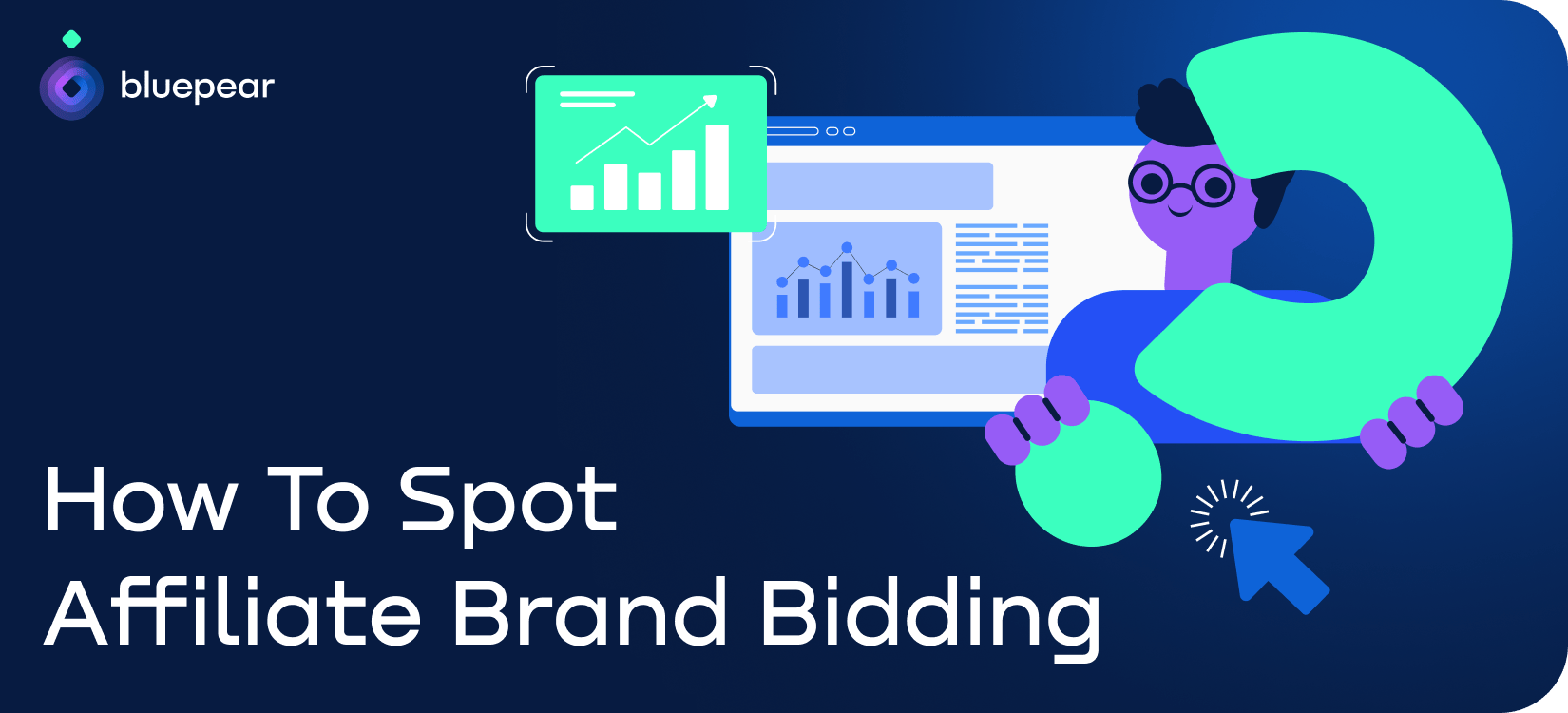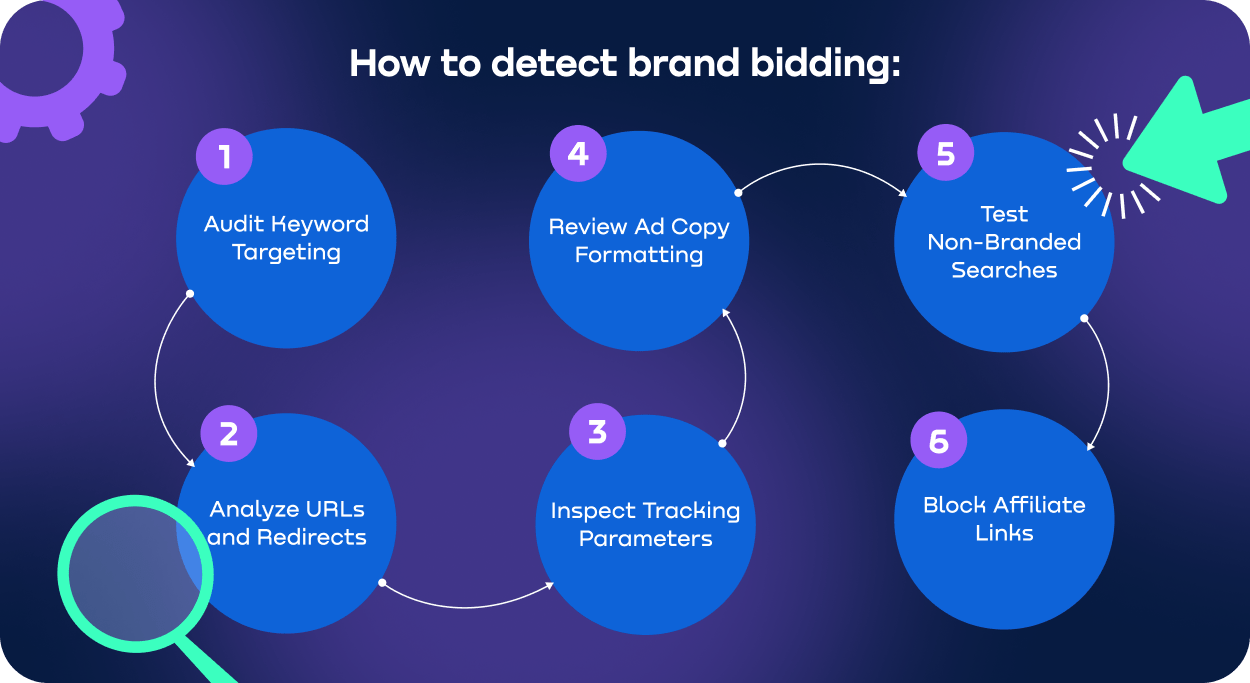
Contents
Understanding PPC Brand Bidding and Its Implications
PPC brand bidding, commonly referred to as bidding on competitor brand names, involves targeting branded keywords in paid search campaigns to capture traffic from competitors or affiliates. While this strategy can drive high-intent users, it poses significant risks to brand integrity and advertising budgets if left unchecked.
Goals of brand bidding
The primary objectives include:
-
Capturing high-value traffic searching for specific brands.
-
Protecting brands from competitors encroaching on their visibility.
-
Mitigating affiliate misuse by monitoring brand bidding activities.
However, unchecked brand bidding escalates costs and legal exposure, making proactive detect brand bidding vital.
Legal risks and brand protection in Google Ads
While competitor brand bidding isn’t inherently illegal, using trademarked terms in ad copy often violates platform policies. Google Ads permits competitors to bid on branded keywords but restricts trademark usage in creatives unless authorized. To enforce brand protection Google Ads guidelines, companies can file trademark complaints, though this doesn’t prevent keyword bidding itself. To enforce brand protection Google Ads guidelines, companies can file trademark complaints, though this doesn’t prevent keyword bidding itself.
Cost implications of unregulated bidding
Heightened competition for branded keywords inflates CPCs, straining marketing budgets. Regular monitoring brand bidding helps identify unauthorized actors, preventing wasteful spend and preserving ROI.
Match types and auto-apply features
Affiliates often exploit broad match keywords or automated tools to unintentionally trigger ads for branded terms. Understanding match types is critical to detect brand bidding:
- Exact Match: Targets precise phrases (e.g., [office chairs]).
- Phrase Match: Triggers ads for queries containing the phrase (e.g., “ergonomic office chairs”).
- Broad Match: Displays ads for loosely related terms (e.g., office furniture – office chairs).
- Negative Match: Blocks ads for specified keywords.
Platforms like Google Ads also use auto-apply recommendations, adding keywords based on landing pages or ad copy. This automation can inadvertently associate affiliates with your brand keywords, complicating efforts to protect brands and prevent brand abuse.
Role of auto-apply recommendations in brand bidding
Auto-apply recommendations are a feature offered by Google Ads and Microsoft Ads that allows search engines to automatically make changes to ad campaigns. These changes can include adding new keywords, adjusting bids, or modifying targeting settings – all without requiring additional approval from the advertiser once the feature is enabled.
How auto-apply recommendations work
The ad platform selects keywords for auto-application from various sources, such as:
-
• Ad copy text
-
• Display URLs
-
• Landing page headlines and content
-
• Related terms and common typos
This means that Google and Microsoft Ads can display ads for keywords your affiliate did not intentionally target. For example, if an affiliate’s landing page mentions your brand, the platform might auto-apply your brand keyword, even if the affiliate never explicitly bid on it.
A significant issue with auto-apply recommendations is that advertisers cannot control how match types trigger paid ads. When a user searches for your brand, an affiliate’s ad might appear not because they intentionally targeted your brand keyword, but because they used broad match keywords or had one auto-applied by the platform. This lack of transparency makes it difficult to determine whether an affiliate is intentionally engaging in PPC brand bidding or if the ad was triggered unintentionally.
How to detect brand bidding: key strategies

1. Audit Keyword Targeting Use tools such as a brand bidding monitoring tool to detect brand bidding by scanning affiliates’ campaigns for exact brand terms, typos (e.g., “Nikee”), or brand+product combinations (e.g., “Adidas running shoes”).
2. Analyze URLs and Redirects Check affiliate landing pages for brand mentions in URLs. If your domain appears in redirects, it signals intentional PPC brand bidding.
3. Inspect Tracking Parameters Affiliates often embed keywords in URL parameters. Dynamic tags like {keyword} reveal the terms triggering their ads.
4. Review Ad Copy Formatting Bold text in ads indicates keyword alignment with search queries. Non-bolded brand terms suggest accidental triggers via broad match.
5. Test Non-Branded Searches Remove your brand from search phrases. If affiliates don’t appear for generic terms (e.g., “running shoes”), they’re likely targeting your brand intentionally.
6. Block Affiliate Links Update agreements to prohibit competitor brand bidding and use platform tools to block affiliate links violating policies.
FAQs: addressing common concerns
Can Competitors Legally Bid on My Brand?
Yes, unless prohibited by trademark law. Brand protection Google Ads tools allow trademark complaints against ad copy misuse, but competitors can still bid on keywords.
How to Stop Bidding on Competitor Brand Names?
File trademark claims with search engines. Enforce strict clauses in affiliate contracts. Continuously monitor brand bidding via specialized software.
Is Brand Bidding Ever Justified?
Authorized resellers may bid on brands to drive sales, but unauthorized affiliates risk partnerships and legal action
Proactive measures to protect brands
1. Leverage Monitoring Tools Platforms like BrandVerity or AdThena, as well as a comprehensive brand protection tool, automate detect brand bidding efforts, flagging unauthorized ads in real time.
2. Update Affiliate Agreements Explicitly ban bidding on competitor brand names and outline penalties for violations.
3. Optimize Match Types Encourage affiliates to use exact/phrase match and exclude branded terms via negative keywords.
4. Regular Audits Conduct quarterly reviews of affiliate campaigns to block affiliate links and ensure compliance.
Conclusion
To protect brands in competitive digital landscapes, businesses must prioritize monitoring brand bidding, refine PPC protect strategies, and enforce strict affiliate guidelines. By combining automated tools with legal safeguards, companies can mitigate risks, control costs, and maintain brand authority. Stay vigilant, adapt to platform updates, and foster transparent partnerships to thrive in the evolving world of PPC brand bidding. By implementing these comprehensive strategies, you can effectively detect brand bidding, safeguard your brand’s reputation, and ensure compliance across all affiliate activities. Remember, proactive measures and continuous monitoring are the keys to long-term success in brand protection Google Ads.
FAQ
What is brand bidding in PPC campaigns?
It’s when affiliates or competitors target your brand name as a keyword to capture high-intent traffic. While common, it inflates CPCs, diverts loyal users, and can mislead customers.
Why is monitoring brand bidding essential for advertisers?
Without oversight, unauthorized bidders drive up branded CPCs, drain budgets, and risk legal complications. A brand bidding monitoring tool helps detect these patterns before they escalate.
How do match types influence accidental or hidden brand bidding?
Broad and phrase match keywords can trigger ads for branded queries even if the affiliate didn’t intend it. Auto-apply recommendations from Google and Microsoft Ads can also add branded terms automatically.
What makes auto-apply recommendations risky for brands?
These features add new keywords based on landing page content or ad text. If your brand name appears on an affiliate’s page, the platform may auto-apply your keyword, causing unintended brand bidding.
How can you detect intentional brand bidding?
Check keyword parameters in URLs, review redirects, analyze bolded text in ads, test non-branded queries, and scan campaigns for typos and brand+product combinations — all signals of targeted bidding.
Can competitors legally bid on your branded terms?
Yes. Google allows keyword bidding on trademarks but restricts use of branded terms in ad copy. You can file trademark complaints to remove misleading ads but not to stop keyword bidding itself.
How can tools like Bluepear support brand bidding monitoring?
Bluepear scans SERPs across GEOs, devices, and dayparts, detects unauthorized brand bidding, analyzes redirects and ad behavior, and compiles evidence reports. It helps pinpoint whether affiliates or competitors intentionally target your brand.

